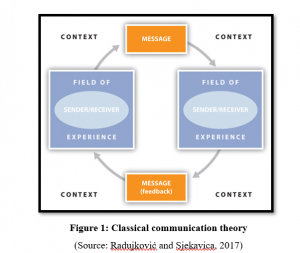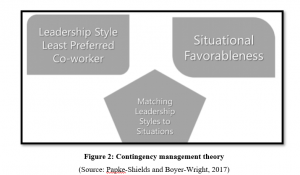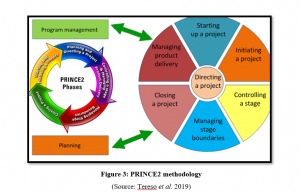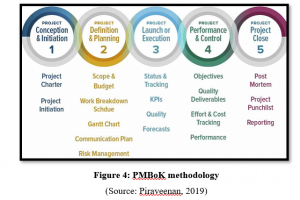BSS060-6 Project Management Assignment Sample
Here’s the best sample of BSS060-6 Project Management Assignment, written by expert.
Executive Summary
The report has focused the project regarding client data in order to improve accounting system as well as increase the client numbers. Two project management theories such as classical management theory and contingency management theory is evaluated for giving proper theoretical backbone for this project. The classical management theory is ideal for this client data project as it can help to communicate with all stakeholders and help to make decisions. In contrast, this study has focused two project development methodologies such as PRINCE2 methodology and PMBoK methodology. The PMBoK methodology can help to implement RANX accounting system in NBB. Several recommendations have been suggested in this study for better future outcomes of selected banking project and its sustainability.
1. Introduction
Aim of the study is to analyze the client data project as well as assess identical project methodology to execute the entire project operation without facing any issues. This study is based on the client data project regarding an American largest bank named New Balanced bank (NBB). LPS consultancy services is a project management specialized consultancy that helps them in project management. Two project management methodologies such as Prince 2 and PMBok are considered in order to develop client data projects. Prince 2 methodology aids to improve the entire project with the customer’s personal style. Application of PMBoK framework for client data project sustainability is discussed throughout the report for critical evaluation of all aspects.
2. Main body
2.1 Project management (PM) theory & methodologies
2.1.1 Critical evaluation of project management theory
Classical communication theory
Classical communication theory plays an important role in any project development as well as it provides assistance for the development of client data projects. In addition, classical communication theory is helpful in the communication of any project management process. As stated by Ika et al. (2020), this communication theory has a very important key feature that aids to monitor all projects with the help of vertical channels. On the contrary, it is said that this project management theory assists managers to control as well as manage all stakeholders of projects. Furthermore, the requirements of the project are met by project managers through this project management theory.

In the context of this study, classical communication theory can help to increase the transparency of the client data project. In contrast, the information technology of this project is developed by this theory which can help to improve problems from the global perspective. As opined by Radujković and Sjekavica (2017), the product quality of this project is developed by this classical communication theory. One more important advantage of using this theory is it helps to complete the entire project within the deadline. Cost management along with risk management is performed by applying this theory.
Contingency management theory
Contingency management theory helps in the planning, organizing, leading, and controlling projects and organizations both. The project manager can identify requirements as well as conditions of tasks through this project. Contingency management theory helps to solve as well as overcome all types of problems (Papke-Shields and Boyer-Wright, 2017).

On the subject of this report, the contingency theory can help the project manager in the decision-making process. As argued by Papke-Shields and Boyer-Wright (2017), the financial crisis of client data projects is solved by project managers through contingency management theory. The LPS consultancy can provide RANX software systems to new balance banks through this project management theory. Furthermore, all requirements of the client data project are met by contingency management theory.
2.1.2 Project management methodologies
PRINCE2 methodology
PRINCE2 methodology is considered as a project management methodology that helps in the project management process. This methodology is applicable for client data projects as well as plays an important role in the improvement of projects. As per the view of Kivilä et al. (2017), this methodology provides full independence and freedom to the project management team in order to complete the entire project successfully and accurately. PRINCE2 methodology has three kinds of perspectives such as users, businesses, and specialists.

PRINCE2 provides confidence to project managers along with helping to execute client data projects. As opined by Tereso et al. (2019), the chief feature of users is to assist the entire project in order to achieve all requirements. Specialist assurance plays an important role in solving problems in order to preserve the entire project from any damage. Besides that, business assurance manages all financial and economic parts of the projects on client data. This methodology provides information to LPS consultancy to improve their tools and technologies as well as the RANX accounting system.
Provide business justification
A project is made on the basis of any business and in this case study, the client data project is made to solve the problem of New Balance Bank. as per the suggestion of Borkovskaya (2018), this stage of PRINCE2 methodology provides ideas regarding resources, investment, return, and other financial parts. On the contrary, this methodology helps to identify risks as well as manages the risks. Usually, this principle plays a role of assistance on this client data project in order to evaluate investments and returns.
Learn from experience
This principle of PRINCE2 methodology helps the project manager to gain experience from the previous project in order to execute the project without facing any issues. As mentioned by Woźniak (2021), it helps project managers not to make any mistakes in the future. Henceforth, it can be said that this project helps to identify mistakes as well as helps to gain information from previous projects.
Define roles and responsibilities
This principle of PRINCE2 methodology explains the roles and responsibilities of project management teams. Therefore, it helps to work with team members properly as well as all requirements of the project are met by team members (Anderson, 2017).
Planned the stages of project
This principle of PRINCE2 methodology splits the project into several steps. Therefore, the entire project is completed accurately and the project manager maintains the entire client data project according to project planning (Saltz and Crowston, 2017).
Manage with expectation
This principle of the PRINCE2 methodology helps to manage the entire project according to the expectation. Therefore, the entire project can be finished with the deadline.
Tailor to the environment
PRINCE2 principle can help the project manager to execute the client data project by managing risks and costs of the project (Sharp and Chowdhury, 2020).
Agile methodology
Agile methodology is a modern approach of project management that in turn can be beneficial to manage all the stages under cross-functional teams. As per the opinion of Beerbaum (2019), it is a self-organizing method in which collaboration of all team members can help to develop authentic projects. In case of client data project, agile methodology can be chosen as strategic option for reducing technological error related with project sustainability. Core sets of values and principles of project management team can be acquired by applying such methodology in international projects (Mohammad, 2017). As a result, adaptability as well as flexibility of projects such as client data can be improved without any technical error.
Advantages of agile methodology are given below to measure its importance for project sustainability as well as tracking of progress in detail.
- Agile methodology is a flexible technique that can help stakeholders to understand aim and objectives of a particular project (Mohammad, 2017).
- Market diversification of project outcome can be achieved easily with the help of agile methodology with an assurance to release final product faster.
- Agile methodology is purposive to improve communication between project manager and all stakeholders related with project (Mohammad, 2017).
PMBoK methodology
PMBoK methodology is a type of framework of standards, conventions, processes, best practices, technologies, and guidelines that help to manage the entire project successively. As stated by Uribe et al. (2020), it is a traditional project management methodology and it consists of five steps such as initiating, planning, executing, controlling, and closing. In addition, this methodology contains various steps and techniques in order to manage entire projects. As per the view of Piraveenan (2019), the project manager understands the requirement of the project through PMBoK methodology.

- PMBoK methodology is valuable for this client data project as it accommodates project managers to standardize their practices. Along with this, this methodology helps the project manager to perform with standardized practices along with the company named New Balance Bank.
- This methodology can help the project manager to assume the risks as well as to overcome all risks and problems of the client data project (Teng, 2018).
Initiating
This stage assists the project manager to understand which skills and activities are required for this project. Basically, this stage allows the project manager to determine the objectives and goals of the project (Ferrer Romero, 2018).
Planning
This process of PMBoK methodology aids the project manager to plan the overall project as well as explains all stages of the client data project clearly.
Executing
This process can assist to execute projects without facing any problems and issues.
Controlling
This stage of PMBoK theory helps to manage risks, costs, deadlines, and resources of the client data project. In addition, it can help monitor the performance as well as the progress of the project (Bondarenko et al. 2018).
Closing
It helps to complete the entire project successfully and future exploration of above mentioned project can be possible.
2.1.3 Justification
Project management theories and project management methodologies both are required for executing the client data project properly. Among the project management theories, classical communication theory and contingency management theory are described in this report. Evidence shows that classical communication theory is applicable for the client data project as it helps to communicate with internal and external stakeholders clearly. As per the opinion of Abd Elhameed (2018), this management theory can help to complete the client data project within the deadline. In contrast, contingency management theory assists the project managers to understand the physical as well as psychological needs of the project.
The classical communication theory can help in making decisions regarding the projects. One of the most important factors of classical communication theory is that it helps in the management of financial parts of the project along with motivating financial investors. As mentioned by Ferreira et al. (2018), the classical communication theory is also suitable for LPS consultancy and project team management. This theory helps to control the work performance of project management teams. This classical communication theory is beneficial for this project for all of these reasons.
Among the project management methodologies, two methods such as PRINCE2 methodology and PMBoK methodology are described in this report. As per the suggestion of Saltz and Crowston (2017), the PMBoK theory is ideal as well as appropriate for the client data project. The PRINCE2 methodology has several issues which can create constraints to the completion of the project. The client data project has an overall 5 million pounds budget. However, it is problematic for LPS consultancy to finish this project within this proposed range by PRINCE2 methodologies. The client data project will not be finished within the deadline by using this methodology.
The PMBoK theory is beneficial for this project because it can help to reduce the project management cost as well as manage investment and return of the project. The aim of the client data project is to increase the numbers of the client that is developed by PMBoK methodology. However, the PRINCE2 methodology cannot fill this requirement as much as possible. Another aim of this project is to implement RANX accounting software and reporting all data rules to all clients. The PRINCE2 methodology is not appropriate for this process and it cannot meet its requirements. On the contrary, PMBoK methodology can meet all requirements and needs of the project clearly. Furthermore, PMBoK methodology can cut extra costs as well as develop an operational strategy for the client data project.
More justifications of choosing PMBoK methodology have been given in this report.
- The employees of NBB used the RPP legacy system for 10 to 12 years and it causes various problems in client management. The LPS consultancy and project manager both can implement the new RANX accounting system by PMBoK methodology. Therefore, local staff can get benefits from them and the number of clients will be increased (Nubuor et al. 2019).
- The NBB used the Lx accounting system which cannot provide benefits to employees. However, establishing a RANX accounting system helps to improve configuration and reporting requirements.
- The Pandora legacy system has been used by all employees of NBB for more years. This can be replaced by the RANX accounting system through PMBoK methodology. The modification of the backdated system can help employees to work better and employee retention will be increased (Bushuiev and Kozyr, 2020).
Agile methodology will not be a good option for client data project as effective resource planning for RANX accounting system cannot be possible. In addition, documentation of employee legacy scheme cannot be acquired with the help of agile technique. As mentioned by Duda et al. (2019), agile methodology is responsible for fragmented output of all data with lack of viability. In case of client data project, analysis of modified configuration is necessary to measure success rate positively. However, agile approach will not be able to fulfill such requirements and will be rejected from project evaluation purpose. Moreover, entire project will be accomplished by following PMBoK methodology due to lack of cost as well as time accuracy.
3. Recommendations
- It has been recommended to the project manager explain the requirements of the project to both internal and external stakeholders of the project. It can help to meet the goals and objectives of the client data project.
- It has suggested the projecting manager to create a risk management team that can help to overcome all types of risks faced by the project.
- It has been recommended to the top project manager to create a plan before executing the project that can help to finish the project within the deadlines.
- Effective communication is one of the important requirements of project management. It has been advised to the project manager to arrange a meeting weekly that can help to communicate with clients, stakeholders, project management teams, and others.
- LPS consultancy has a poor leadership style and it needs to improve. It has been suggested to the project managers and LPS consultancy to develop a leadership style. It can help to provide better technology services to the client data project. Along with this, it can help to get success in project development (Swinnerstone and Lubega, 2019).
- It has been advised to monitor as well as track the progress of the project on a regular or weekly basis. It helps to prevent and assumes future issues.
- Risk identification and risk management are one of the main parts of project management. It has been suggested to the project manager to look out for potential risks. Addressing risk can help to prevent the negative impacts on budget, employee morale, and others.
4. Conclusion
It is concluded that the client data project is mainly based on solving problems of New Balanced Bank with the help of LPC consultancy. Two project management theory such as contingency management theory and classical management theory helps to run the entire project accurately. It has been found from the above context, the client data project is made for proper governance of clients. It can be also seen from the research that there is a use of a Risk register plan to understand the threats regarding the company. Two project management methods such as PMBoK and PRINCE 2 methodology are described in this context. It has been found from research the PMBoK methodology is ideal for client data project development. Brief recommendations are provided in this study that can help to get success in developing this project.
References
Abd Elhameed, A.T., 2018. Analyzing the Project Management Body of Knowledge (PMBOK) through theoretical lenses: A study to enhance the PMBOK through the project management theories. PM World Journal, 6, pp.1-31.
Anderson, J.L., 2017. Methods for Safeguarding Client Data.
Beerbaum, D., 2019. Applying Agile Methodology to regulatory compliance projects in the financial industry: A case study research. Journal of Applied Research in the Digital Economy (JADE), Special Issue, 2.
Bondarenko, S., Lagodienko, V., Sedikova, I. and Kalaman, O., 2018. Application of project analysis software in project management in the pre-investment phase. Journal of Mechanical Engineering and Technology, 9(13), pp.676-684.
Borkovskaya, V., 2018. Project management risks in the sphere of housing and communal services. In MATEC Web of Conferences (Vol. 251, p. 06025). EDP Sciences.
Bushuiev, D. and Kozyr, B., 2020. Hybrid infrastructure project management methodologies. Innovative Technologies and Scientific Solutions for Industries, (1 (11)), pp.35-43.
Duda, J., Puka, R. and Puka, A., 2019. Adoption of Project Management Methodologies in Polish IT Companies. Jan Sas, p.49.
Ferreira, L., Lopes, N., Ávila, P.S., Castro, H., Varela, M.L.R., Putnik, G.D., Martinho, R., Rijo, R., Miranda, I.M. and Cruz-Cunha, M.M., 2017. Virtual Enterprise integration management based on a Meta-enterprise–a PMBoK approach. Procedia Computer Science, 121, pp.1112-1118.
Ferrer Romero, E.F., 2018. Strategic project management: a methodology for sustainable competitive advantage. Revista EAN, (spe), pp.15-31.
Garrido-Lopez, M., Hillon, Y.C., Cagle, W. and Wright, E., 2018. Project-based strategic management education: A client perspective on key challenges. Journal of Small Business Strategy, 28(2), pp.68-79.
Ika, L.A., Söderlund, J., Munro, L.T. and Landoni, P., 2020. Cross-learning between project management and international development: Analysis and research agenda. International Journal of Project Management, 38(8), pp.548-558.
Kivilä, J., Martinsuo, M. and Vuorinen, L., 2017. Sustainable project management through project control in infrastructure projects. International Journal of Project Management, 35(6), pp.1167-1183.
Mohammad, S.M., 2017. DevOps automation and Agile methodology. International Journal of Creative Research Thoughts (IJCRT), ISSN, pp.2320-2882.
Nubuor, S.A., Dartey-Baah, K. and Kasanga, N.A.B., 2019. The Use of Project Management Methodologies in Reducing Project Delays: Evidence from the Adentan Municipal Assembly in Ghana.
Papke-Shields, K.E. and Boyer-Wright, K.M., 2017. Strategic planning characteristics applied to project management. International Journal of Project Management, 35(2), pp.169-179.
Piraveenan, M., 2019. Applications of game theory in project management: a structured review and analysis. Mathematics, 7(9), p.858.
Radujković, M. and Sjekavica, M., 2017. Project management success factors. Procedia engineering, 196, pp.607-615.
Saltz, J. and Crowston, K., 2017. Comparing data science project management methodologies via a controlled experiment.
Saltz, J. and Crowston, K., 2017. Comparing data science project management methodologies via a controlled experiment.
Sharp, R. and Chowdhury, S., 2020. CLIENT PROJECT REPORT CPR2807.
Sirshar, M., Amir, K. and Daud, M., A comparative Analysis of Various Methodologies of Agile Project Management Verses PMBOK: A Case Study.
Swinnerstone, E.M. and Lubega, J.T., 2018. Utilization of Agile Project Management Methodologies and the Success of Software Development Projects at Flock of Birds Uganda. International Journal of Technology and Management, 3(2), pp.19-19.
Teng, X., 2018. Discussion on the Application of Effective Management Theory in Commercial Aircraft Project Management.
Tereso, A., Ribeiro, P., Fernandes, G., Loureiro, I. and Ferreira, M., 2019. Project management practices in private organizations. Project Management Journal, 50(1), pp.6-22.
Uribe, D.F., Ortiz-Marcos, I. and Uruburu, Á., 2018. What is going on with stakeholder theory in project management literature? A symbiotic relationship for sustainability. Sustainability, 10(4), p.1300.
Woźniak, M., 2021. Sustainable Approach in IT Project Management—Methodology Choice vs. Client Satisfaction. Sustainability, 13(3), p.1466.
Bibliography
Abid, S., Antipin, M. and Timorabadi, H.S., 2018. Flipping the Script on Project Management Practices in Education: Outcomes of Applying Agile Development Methodologies in a Classroom Setting. Proceedings of the Canadian Engineering Education Association (CEEA).
________________________________________________________________________________
Know more about UniqueSubmission’s other writing services:


https://twrd.in/nzTY3lz
https://ug.wpcookie.pro
I could not resist commenting. Exceptionally well written!
https://twrd.in/CXuy16h